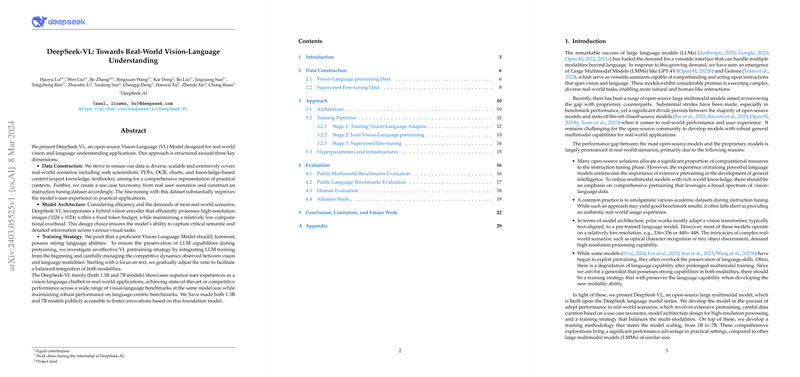DeepSeek-VL: A New Horizon in Vision-LLMs
Introduction
The integration of vision and language understanding has long been a challenging yet critical goal in artificial intelligence research. Vision-LLMs (VLMs) are at the forefront of bridging this gap, enabling machines to comprehend and generate responses based on visual and textual inputs. DeepSeek-VL presents an innovative leap in the development of open-source VLMs, offering a pragmatic approach optimized for real-world applications. Drawing from the strengths of LLMs, DeepSeek-VL introduces a novel methodology to retain linguistic abilities while embracing multimodal data during pretraining. This entry focuses on the distinct strategies employed in DeepSeek-VL’s creation, including data construction, model architecture, training strategies, and a comprehensive evaluation across a range of benchmarks.
Model Architecture
DeepSeek-VL incorporates a hybrid vision encoder that efficiently handles high-resolution images, a crucial aspect of understanding detailed visual information. The model's architecture is designed to process 1024 x 1024 resolution images within a fixed token budget, showcasing an effective balance between capturing essential details and maintaining low computational demands. This architectural choice addresses the challenge of processing complex real-world scenarios, such as fine-grained object recognition and detailed OCR tasks.
Data Construction
The robustness of DeepSeek-VL is significantly attributable to its extensive pretraining data, meticulously curated to cover a wide spectrum of real-world scenarios. This dataset spans from web screenshots, PDFs, and OCR tasks to charts and knowledge-based content, ensuring a broad representation of practical contexts. Additionally, the model benefits from an instruction-tuning dataset specifically designed around real user scenarios, enhancing its relevance and effectiveness in practical applications.
Training Strategy
A key innovation in DeepSeek-VL's development is the strategic approach to training, aimed at preserving the model's language capabilities while incorporating vision and language modalities. The training begins with a significant emphasis on text, gradually adjusting the multimodal ratio to ensure a balanced development of both capabilities. This method effectively prevents the potential degradation of linguistic performance, a common challenge faced by multimodal models.
Evaluation and Implications
DeepSeek-VL has undergone rigorous testing across a broad spectrum of visual-language benchmarks, achieving state-of-the-art or highly competitive performance. The model demonstrates superior capabilities in language understanding, visual comprehension, and multimodal interaction, marking it as a significant contribution to the field. DeepSeek-VL’s performance highlights its potential as a foundational model for a wide range of applications, pushing the boundaries of what is achievable with open-source VLMs.
Limitations and Future Directions
Despite its achievements, DeepSeek-VL has limitations, particularly in scaling the model size and integrating Mixture of Experts (MoE) technology. Future work will focus on overcoming these challenges, with plans to scale up DeepSeek-VL and enhance its efficiency, potentially setting new benchmarks in the VLM landscape.
Conclusion
DeepSeek-VL represents a significant stride towards realizing the full potential of vision-LLMs. By effectively combining deep language understanding with robust visual processing capabilities, DeepSeek-VL sets a new standard for open-source models in real-world applications. Its development strategy, focused on comprehensive pretraining, careful data curation, and a balanced training approach, provides valuable insights for future advancements in VLMs.
